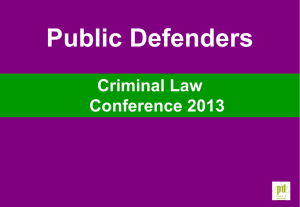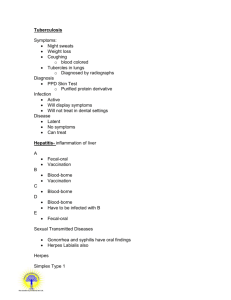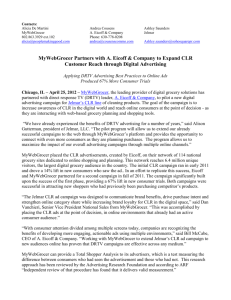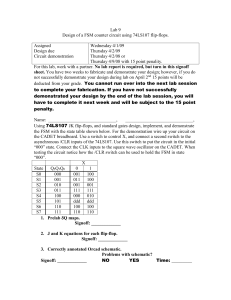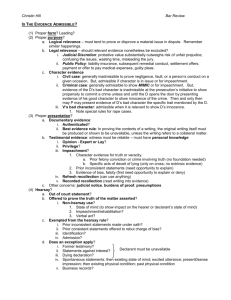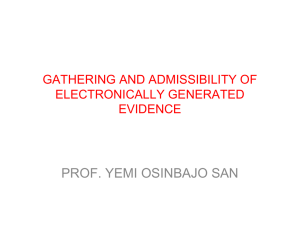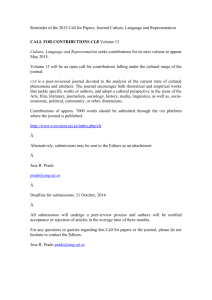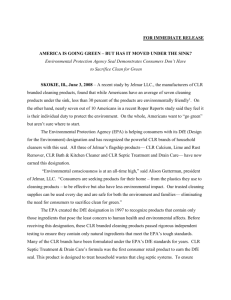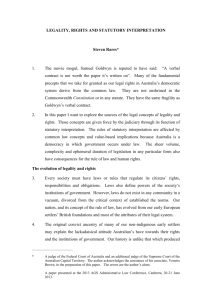Evidence Admissibility Flowchart: Legal Rules & Guidelines
advertisement
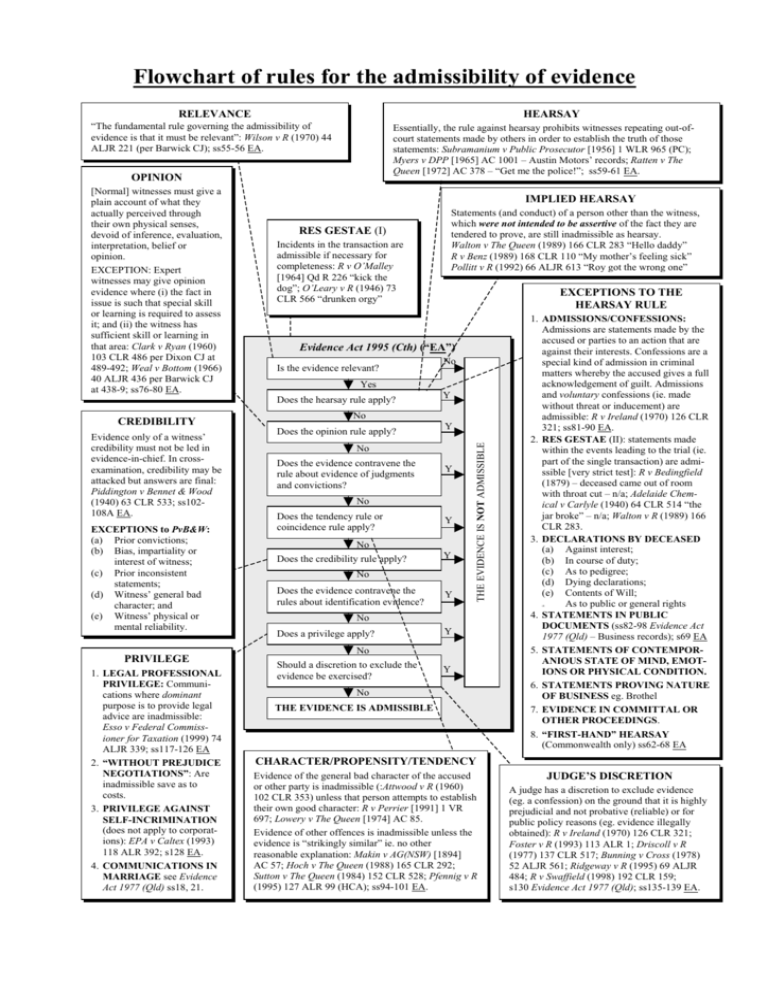
Flowchart of rules for the admissibility of evidence RELEVANCE HEARSAY “The fundamental rule governing the admissibility of evidence is that it must be relevant”: Wilson v R (1970) 44 ALJR 221 (per Barwick CJ); ss55-56 EA. Essentially, the rule against hearsay prohibits witnesses repeating out-ofcourt statements made by others in order to establish the truth of those statements: Subramanium v Public Prosecutor [1956] 1 WLR 965 (PC); Myers v DPP [1965] AC 1001 – Austin Motors’ records; Ratten v The Queen [1972] AC 378 – “Get me the police!”; ss59-61 EA. OPINION CREDIBILITY Evidence only of a witness’ credibility must not be led in evidence-in-chief. In crossexamination, credibility may be attacked but answers are final: Piddington v Bennet & Wood (1940) 63 CLR 533; ss102108A EA. EXCEPTIONS to PvB&W: (a) Prior convictions; (b) Bias, impartiality or interest of witness; (c) Prior inconsistent statements; (d) Witness’ general bad character; and (e) Witness’ physical or mental reliability. PRIVILEGE 1. LEGAL PROFESSIONAL PRIVILEGE: Communications where dominant purpose is to provide legal advice are inadmissible: Esso v Federal Commissioner for Taxation (1999) 74 ALJR 339; ss117-126 EA 2. “WITHOUT PREJUDICE NEGOTIATIONS”: Are inadmissible save as to costs. 3. PRIVILEGE AGAINST SELF-INCRIMINATION (does not apply to corporations): EPA v Caltex (1993) 118 ALR 392; s128 EA. 4. COMMUNICATIONS IN MARRIAGE see Evidence Act 1977 (Qld) ss18, 21. IMPLIED HEARSAY Statements (and conduct) of a person other than the witness, which were not intended to be assertive of the fact they are tendered to prove, are still inadmissible as hearsay. Walton v The Queen (1989) 166 CLR 283 “Hello daddy” R v Benz (1989) 168 CLR 110 “My mother’s feeling sick” Pollitt v R (1992) 66 ALJR 613 “Roy got the wrong one” RES GESTAE (I) Incidents in the transaction are admissible if necessary for completeness: R v O’Malley [1964] Qd R 226 “kick the dog”; O’Leary v R (1946) 73 CLR 566 “drunken orgy” EXCEPTIONS TO THE HEARSAY RULE Evidence Act 1995 (Cth) (“EA”) Is the evidence relevant? No Yes Does the hearsay rule apply? Y No Does the opinion rule apply? Y No Does the evidence contravene the rule about evidence of judgments and convictions? Y No Does the tendency rule or coincidence rule apply? Y No Does the credibility rule apply? Y No Does the evidence contravene the rules about identification evidence? Y THE EVIDENCE IS NOT ADMISSIBLE [Normal] witnesses must give a plain account of what they actually perceived through their own physical senses, devoid of inference, evaluation, interpretation, belief or opinion. EXCEPTION: Expert witnesses may give opinion evidence where (i) the fact in issue is such that special skill or learning is required to assess it; and (ii) the witness has sufficient skill or learning in that area: Clark v Ryan (1960) 103 CLR 486 per Dixon CJ at 489-492; Weal v Bottom (1966) 40 ALJR 436 per Barwick CJ at 438-9; ss76-80 EA. (f) No Does a privilege apply? Y No Should a discretion to exclude the evidence be exercised? 1. ADMISSIONS/CONFESSIONS: Admissions are statements made by the accused or parties to an action that are against their interests. Confessions are a special kind of admission in criminal matters whereby the accused gives a full acknowledgement of guilt. Admissions and voluntary confessions (ie. made without threat or inducement) are admissible: R v Ireland (1970) 126 CLR 321; ss81-90 EA. 2. RES GESTAE (II): statements made within the events leading to the trial (ie. part of the single transaction) are admissible [very strict test]: R v Bedingfield (1879) – deceased came out of room with throat cut – n/a; Adelaide Chemical v Carlyle (1940) 64 CLR 514 “the jar broke” – n/a; Walton v R (1989) 166 CLR 283. 3. DECLARATIONS BY DECEASED (a) Against interest; (b) In course of duty; (c) As to pedigree; (d) Dying declarations; (e) Contents of Will; As to public or general rights 4. STATEMENTS IN PUBLIC DOCUMENTS (ss82-98 Evidence Act 1977 (Qld) – Business records); s69 EA 5. STATEMENTS OF CONTEMPORANIOUS STATE OF MIND, EMOTIONS OR PHYSICAL CONDITION. 6. STATEMENTS PROVING NATURE OF BUSINESS eg. Brothel 7. EVIDENCE IN COMMITTAL OR OTHER PROCEEDINGS. 8. “FIRST-HAND” HEARSAY (Commonwealth only) ss62-68 EA Y No THE EVIDENCE IS ADMISSIBLE CHARACTER/PROPENSITY/TENDENCY Evidence of the general bad character of the accused or other party is inadmissible (:Attwood v R (1960) 102 CLR 353) unless that person attempts to establish their own good character: R v Perrier [1991] 1 VR 697; Lowery v The Queen [1974] AC 85. Evidence of other offences is inadmissible unless the evidence is “strikingly similar” ie. no other reasonable explanation: Makin v AG(NSW) [1894] AC 57; Hoch v The Queen (1988) 165 CLR 292; Sutton v The Queen (1984) 152 CLR 528; Pfennig v R (1995) 127 ALR 99 (HCA); ss94-101 EA. JUDGE’S DISCRETION A judge has a discretion to exclude evidence (eg. a confession) on the ground that it is highly prejudicial and not probative (reliable) or for public policy reasons (eg. evidence illegally obtained): R v Ireland (1970) 126 CLR 321; Foster v R (1993) 113 ALR 1; Driscoll v R (1977) 137 CLR 517; Bunning v Cross (1978) 52 ALJR 561; Ridgeway v R (1995) 69 ALJR 484; R v Swaffield (1998) 192 CLR 159; s130 Evidence Act 1977 (Qld); ss135-139 EA.
